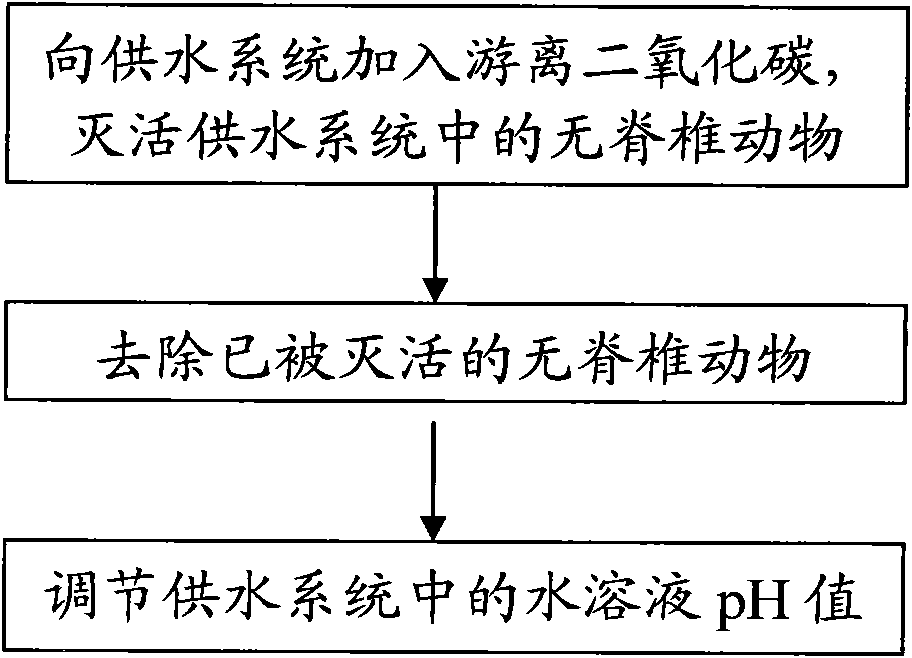Method for inactivating invertebrates in water supply system and application thereof
A technology for invertebrates and water supply systems, which is applied to the field of invertebrate inactivation in water supply systems, can solve the problems of long time and large dose, and achieve the effects of small dose, convenient operation and fast killing speed.
- Summary
- Abstract
- Description
- Claims
- Application Information
AI Technical Summary
Problems solved by technology
Method used
Image
Examples
Embodiment 1
[0044] As attached figure 1 As shown, the method of inactivating invertebrates in the water supply system includes the following steps:
[0045] Step (1): Add free carbon dioxide to increase the concentration of free carbon dioxide in the water supply system, reduce the oxygen carrying capacity of invertebrate hemoglobin, and then inactivate the invertebrates in the water supply system
[0046] This is specifically: adding bicarbonate or carbonate solution and dilute acid solution to the target structure, and using acid-base neutralization reaction to generate free carbon dioxide.
[0047] Add sodium bicarbonate to the target structure at a ratio of 0.42g / L. The sodium bicarbonate solution and the filter material of the filter were thoroughly mixed for 5 minutes by air flushing. Filter material includes activated carbon filter material (broken carbon, columnar carbon) and quartz sand filter material. Then, within 2 minutes, a 0.005 mol / L dilute hydrochloric acid solution of the sa...
Embodiment 2
[0055] The method of inactivating invertebrates in the water supply system includes the following steps:
[0056] Step (1): Add free carbon dioxide to increase the concentration of free carbon dioxide in the water supply system, reduce the oxygen carrying capacity of invertebrate hemoglobin, and then inactivate the invertebrates in the water supply system
[0057] The free gaseous carbon dioxide is produced by the free carbon dioxide generator, and the free carbon dioxide solution is delivered to the target structure and the pipe network, and the free carbon dioxide solution fully contacts the invertebrates in the filter during the air flushing. The free carbon dioxide concentration in the target structure and pipe network is 0.2g / L.
[0058] Step (2): Remove inactivated invertebrates from the water supply system
[0059] After reacting for 15 minutes, remove the inactivated invertebrates from the target structure and pipe network by air-water backwashing, and air-water combined backw...
Embodiment 3
[0061] The method of inactivating invertebrates in the water supply system includes the following steps:
[0062] Step (1): Add free carbon dioxide to increase the concentration of free carbon dioxide in the water supply system, reduce the oxygen carrying capacity of invertebrate hemoglobin, and then inactivate the invertebrates in the water supply system
[0063] After being pressurized directly by a pressurized water jet, the finished liquid carbon dioxide is delivered to the target structure and pipe network to increase the concentration of free carbon dioxide in the water of the structure. The free carbon dioxide concentration in the target structure and pipe network is 1.0g / L.
[0064] Step (2): Remove inactivated invertebrates from the water supply system
[0065] After reacting for 1 min, the inactivated invertebrates in the target structure and pipe network are removed by flushing with water.
PUM
 Login to View More
Login to View More Abstract
Description
Claims
Application Information
 Login to View More
Login to View More - R&D
- Intellectual Property
- Life Sciences
- Materials
- Tech Scout
- Unparalleled Data Quality
- Higher Quality Content
- 60% Fewer Hallucinations
Browse by: Latest US Patents, China's latest patents, Technical Efficacy Thesaurus, Application Domain, Technology Topic, Popular Technical Reports.
© 2025 PatSnap. All rights reserved.Legal|Privacy policy|Modern Slavery Act Transparency Statement|Sitemap|About US| Contact US: help@patsnap.com

